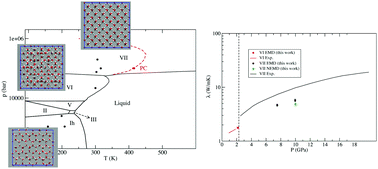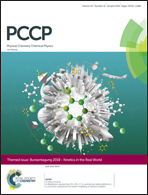Thermal conductivity of ice polymorphs: a computational study†
Abstract
Thermal transport in ice features an unusual response. In addition to its intrinsic scientific interest, an understanding of the mechanisms determining the thermal conductivity of ice might be relevant in climate modelling and planetary science. Accurate microscopic models can provide important molecular insight into these mechanisms. In this work, we quantify using molecular simulations and state of the art forcefields, the thermal conductivity of ice Ih, VI, VII and a plastic phase that has been proposed very recently at pressures in the GPa range. The TIP4P models used in this study underestimate significantly the thermal conductivity of ice Ih and ice VII, while they show good agreement with experimental measurements of ice VI. The discrepancies observed are examined by investigating the temperature dependence of the thermal conductivity. The simulations indicate that the models are too anharmonic and they potentially feature a higher structural disorder than the experimental systems. We suggest that at high pressures the simulated thermal conductivities can be rationalized in terms of the performance of the models in predicting the equation of state of ice. The thermal conductivity of the plastic phase is very similar to that of the coexisting ice VII. Since the water molecules in the plastic phase feature orientational disorder, these results indicate that the hydrogen bond network does not play a significant role in defining the thermal transport mechanisms of ice at high pressures.

- This article is part of the themed collection: 2018 PCCP HOT Articles


 Please wait while we load your content...
Please wait while we load your content...